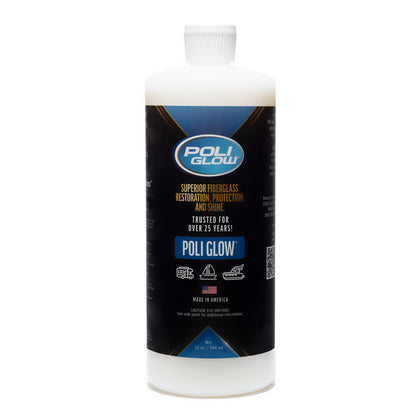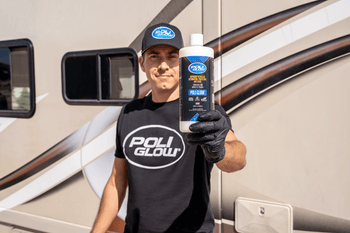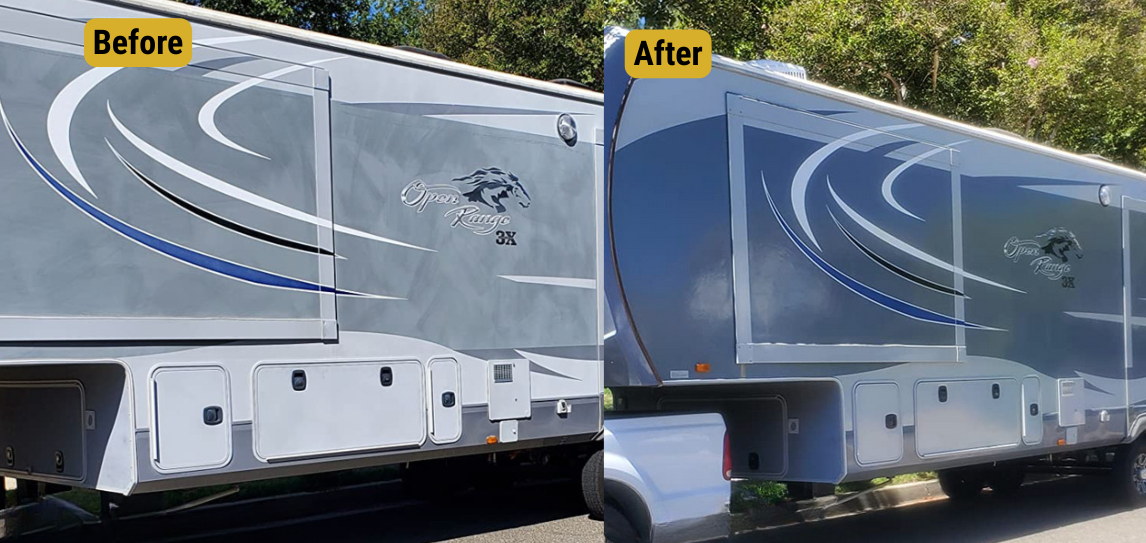
Revitalize Your Boat's Luster with Fiberglass Polishing Techniques
Time to read 14 min
Fiberglass is a combination of durability and flexibility, widely used in the construction of boats due to its structural strength and visual appeal. However, over time, external factors can diminish its shine and appearance. Enter fiberglass polishing: a systematic approach to revitalize the boat's surface and restore its original color and luster.
In this article, we will explore the various fiberglass polishing techniques that are crucial in enhancing a boat's aesthetic and extending its longevity. Additionally, we'll discuss the necessary tools and materials for effective fiberglass polishing, guiding readers on selecting the appropriate compounds and abrasives to ensure they are well-prepared for this maintenance task.
Fiberglass Polishing
Fiberglass is a composite material of plastic reinforced with fine glass fibers. Due to its composite nature, fiberglass offers boats both strength and a sleek finish. Over time, however, these vessels are subjected to environmental stressors such as UV rays, saltwater, and general wear and tear, causing the surface to become dull or chalky. This deterioration affects the boat's visual appeal and can compromise the integrity of the fiberglass if left unchecked.
Polishing fiberglass boats is more than a cosmetic endeavor. Regular polishing acts as a preventive measure, ensuring that the surface remains free from contaminants and minor abrasions that can escalate into more significant issues. Maintaining a boat's appearance is crucial not only for aesthetic reasons but also for preserving its value and ensuring optimal performance on the water. By understanding the importance and techniques of fiberglass polishing, boat owners can ensure their vessels remain in prime condition, both visually and structurally.
Assessing Your Boat's Polishing Needs
Understanding the current state of your boat's fiberglass surface is paramount before embarking on any polishing regimen. A systematic evaluation will reveal the overall condition and pinpoint specific areas requiring more intensive care. Here's how to meticulously assess your boat's polishing needs:
- Visual Inspection: Begin with a broad visual assessment of the entire boat. Look for signs of dullness, discoloration, and chalkiness. These indicators often suggest that the boat's gel coat has been exposed to prolonged environmental stressors.
- Touch Test: Run your hand across the surface of the boat. If it feels rough or gritty, this is a sign of minor oxidation or embedded contaminants. A smooth surface, on the other hand, indicates that the fiberglass is in relatively good condition.
- Check for Scratches and Scuffs: These are common, especially on the hull or near docking areas. While minor scratches can often be addressed with polishing, deeper gouges may require more extensive repairs.
- Identify Stains and Discolorations: Stains from water, rust, or other contaminants can often be treated with specialized cleaning agents before polishing. However, ensure you know the origin of the stain for effective treatment.
- Evaluate Previous Treatments: If your boat has undergone prior polishing or waxing sessions, it's essential to consider the products used. Some polishing compounds and waxes may influence how you approach the current polishing task.
- Focus on High-Wear Areas: Parts of the boat that come into frequent contact with water, ropes, or docking equipment exhibit more wear. Pay special attention to these zones, as they may require a more rigorous polishing effort.
By systematically assessing your boat's condition, you can develop a tailored approach to fiberglass polishing, ensuring that each section of the vessel receives the attention it deserves. Proper evaluation leads to a more effective polishing session, prolongs the lifespan, and enhances the boat's appearance.
Essential Tools and Materials for Effective Fiberglass Polishing
To effectively perform fiberglass polishing and achieve optimal outcomes, you will need various tools and materials designed for this purpose. Here is a comprehensive list of essential items you'll need for effective fiberglass polishing:
- Polishing Compound - A high-quality marine-grade polishing compound is vital. Depending on the degree of oxidation or surface scratches, one may need to select compounds with varying levels of abrasiveness.
- Boat Wax or Sealant: After polishing, a protective layer is essential to seal the finish and impart a shine. Marine-specific waxes or sealants offer protection against UV rays, salt, and other environmental factors.
- Electric Polisher: An orbital buffer or rotary polisher is recommended for efficient and consistent results. An orbital buffer is often recommended for those less experienced, as it minimizes the risk of burning or damaging the surface. While providing a deeper polish, Rotary polishers require more skill to operate.
- Polishing Pads: Different pads, ranging from abrasive to fine, are required throughout the polishing process. Foam, wool, and microfiber pads are common types, each serving specific polishing stages.
- Microfiber Cloths: These towels are indispensable for removing excess compounds, buffing, and ensuring a streak-free finish.
- Cleaning Agents: Before commencing the polishing process, the boat's surface should be thoroughly cleaned using a mild detergent or boat-specific cleaning solution to remove dirt, grime, and contaminants.
- Protective Gear: Safety is paramount. Safety goggles, protective gloves, and a dust mask are advisable, especially when working with chemicals or confined spaces.
- Masking Tape and Plastic Sheeting: To protect areas that shouldn't be polished, like hardware, decals, or sensitive electronics, use tape and sheeting to mask them off.
- Detailing Brushes: For those hard-to-reach nooks and crannies, detailing brushes provide the precision required to ensure every inch of the boat gets the attention it needs.
- Spray Bottles: Filled with water, a spray bottle is essential to keep the surface lubricated during the polishing process, helping achieve uniform results.
- Bucket and Sponges: For the initial cleaning phase, having a bucket to mix cleaning solutions and sponges to scrub surfaces ensures the boat is prepped and ready for polishing.
Incorporating these tools and materials into the fiberglass polishing routine ensures an effective process and a finish that revives and protects the boat's appearance.
It's important to note that the specific tools and materials required may vary depending on your boat's condition and the extent of restoration or polishing you desire. Always adhere to the manufacturer's guidelines for each product and tool, and if you're unfamiliar with the process, consider seeking guidance from professionals in the field.
Preparing Your Boat for Polishing
Preparing your boat for polishing is crucial to achieving optimal results. Here's a step-by-step guide on how to properly prepare your boat for polishing:
- Clean the Surface: Ensuring the boat's surface is clean before any polishing endeavor is essential. Use a marine-specific cleaning solution or a mild detergent to wash the boat thoroughly, removing any dirt, grime, algae, or other contaminants. This provides a clean base for polishing and prevents abrasive particles from scratching the surface.
- Dry Completely: After washing, ensure the boat is dried completely. Any remaining water can interfere with the polishing compound and dilute its effectiveness. Use microfiber towels or chamois cloths for efficient drying, ensuring no water spots or streaks remain.
- Move to a Suitable Location: Move the boat to a shaded location. Direct sunlight can cause polishing compounds to dry too quickly, making them less effective and more difficult to work with.
- Mask Off Adjacent Areas: Using masking tape and plastic sheeting, protect areas that should not come in contact with the polishing compound. This includes hardware, non-fiberglass surfaces, decals, and sensitive electronics. This ensures that only the areas intended for polishing are treated and prevents unintended damage or discoloration to other parts.
- Inspect the Fiberglass Surface: Conduct a thorough visual inspection of the fiberglass surface. Identify any deep scratches, gouges, or areas of heavy oxidation. These areas may require special attention or a more abrasive polishing compound.
- Prepare Your Tools and Materials: Having all your essential tools and materials organized and within reach streamlines the polishing process. Ensure your electric polisher has a charged battery or is plugged in, and have multiple polishing pads available to swap out as needed.
- Wear Protective Gear: Before starting the polishing process, equip yourself with the necessary protective gear. This includes safety goggles, gloves, and a dust mask. Polishing can release particles and vapors, and it's crucial to ensure you're protected.
By meticulously preparing the boat and ensuring all necessary precautions and steps are taken, you can achieve a smoother, more efficient polishing experience, ultimately resulting in a more brilliant and lasting finish for your vessel.
Choosing the Right Polishing Compounds and Abrasives
Fiberglass boats require specific care to maintain their brilliant shine. An essential aspect of this care is selecting the right polishing compounds and abrasives tailored for fiberglass surfaces. Here's a guide to assist you in this selection process:
- Understand the Levels of Abrasiveness: Polishing compounds come in various levels of abrasiveness. The selection typically depends on the condition of the boat's surface.
- Heavy-Cut Compounds: These are highly abrasive and are designed to remove severe oxidation, deep scratches, and significant imperfections. They are optimal for boats that haven’t been polished for quite some time.
- Medium-Cut Compounds: Suitable for moderate oxidation and lighter scratches, these compounds offer a balance between aggressive cutting and finishing.
- Finishing Compounds: With minimal abrasiveness, these are intended for boats with light oxidation or as a final step after using a more abrasive compound to restore shine.
Before choosing a compound, assess the boat's surface. If the gel coat is heavily oxidized or has deep scratches, you should start with a heavy-cut compound and then move to a finer compound for finishing.
- Opt for Marine-Specific Products: Always choose polishing compounds specifically formulated for marine applications. Marine-grade products are designed to withstand the aquatic environment and often provide UV protection to prevent further oxidation.
- Choose the Right Polishing Pad: Different polishing pads complement different compounds:
- Wool Pads: These are typically more abrasive, suitable for heavy-cut compounds.
- Foam Pads: Available in varying levels of firmness, foam pads are used for both cutting and finishing processes.
Before applying the compound to the entire boat, test it on a small, inconspicuous area. This allows you to see how the compound works on your specific boat's surface and ensures you achieve the desired results.
To accurately assess a product's performance, it's advisable to refer to feedback from marine industry experts and other boat owners. Practical experiences offer crucial information regarding a product's functionality and ease of use.
By understanding the needs of your boat's surface and making informed decisions, you can ensure that your vessel remains pristine, reflecting its true elegance on the water.
Fiberglass Polishing Techniques: Mastering Even Application and Pressure
Fiberglass requires specific polishing techniques to maintain its visual appeal and structural integrity. Here's a closer look into mastering these techniques:
- Understanding the Importance of Even Application: Achieving a consistent finish on fiberglass surfaces hinges on the uniform application of polishing compounds. Uneven application can yield patchy results, diminishing the boat's overall aesthetic appeal.
- Sectioning the Surface: To ensure even application, divide the fiberglass surface into manageable sections, often squares of 2x2 feet. Working section by section allows for better control and consistent coverage.
- Using the Right Applicator: The choice of the applicator can influence the application's uniformity. Foam or microfiber pads are commonly used for their ability to distribute compounds evenly without causing abrasions.
- Techniques for Even Pressure: Consistent pressure during polishing ensures that the compound penetrates the surface uniformly, providing a consistent finish. Variations in pressure can cause streaks or leave residues.
- Hand Polishing: While time-consuming, hand polishing allows for great control over pressure. When polishing by hand, use circular motions and ensure the hand remains flat against the surface.
- Machine Polishing: Electric or pneumatic buffers provide faster results but require practice to maintain even pressure. Holding the machine steady and moving it in overlapping patterns can ensure a uniform application.
- Periodic Inspection: Frequently inspect the surface after polishing each section. This will help identify areas needing more attention or reveal sections with uneven pressure or application.
- Final Buffing: After the initial application of the compound, use a clean, soft cloth or a fresh pad to buff the surface gently. This step enhances the shine and rectifies any minor inconsistencies in the application.
- Routine Maintenance and Practice: Regularly polishing your fiberglass boat ensures you become more accustomed to achieving even application and pressure. Over time, this practice leads to better results and a more streamlined polishing process.
The art of fiberglass polishing revolves around meticulous techniques, with even application and pressure at its core. Mastering these aspects ensures that the fiberglass surface retains its brilliant shine, offering both functional and aesthetic benefits for boat enthusiasts.
Buffing and Finishing Techniques: Achieving a High-Gloss Finish
After meticulous polishing, the journey towards a stunning bright shine is incomplete without the final touch: buffing and finishing. Buffing, fundamentally, is the smoothing of the surface to enhance its reflective properties. It gives the fiberglass a mirror-like finish when done correctly, highlighting the boat's contours and lines. Below are the detailed steps and techniques to ensure your boat radiates in all its glory.
- Choosing the Right Buffing Pad: The choice of a buffing pad can influence the final outcome. Foam buffing pads are typically preferred due to their gentle nature and effective results. These pads come in varying textures – from coarse to fine – and the selection largely depends on the level of shine desired.
- Buffing Compounds: After polishing, a fine or finishing buffing compound should be chosen. These compounds are formulated to refine the surface further and prepare it for the final finish. They are lighter and less abrasive than polishing compounds.
-
Buffing Technique: Begin by applying a small amount of the buffing compound to the pad or directly to the boat's surface and using either hand or machine buffing.
- Hand Buffing: Gently spread the compound across the section using circular motions. Ensure that you are using consistent and even pressure throughout.
- Machine Buffing: Set the buffer to a low-to-medium speed to spread the compound. Once spread, increase the speed for effective buffing. Move the buffer in overlapping patterns, ensuring even coverage.
- Monitoring Buffing Temperature: It's essential to touch the surface occasionally. If it's too hot, it could indicate excessive friction, which may damage the fiberglass. In such cases, either reduce buffer speed or increase its movement.
-
Final Finishing Techniques: After buffing, the final finishing products, like waxes or sealants, can be applied. These products enhance the shine and protect the fiberglass from UV damage and other environmental elements.
- Application: Use a soft, clean microfiber or foam pad to apply finishing products. Follow the product's guidelines for best results.
- Final Buff: Once the finishing product has been applied and allowed to haze (if required), use a fresh microfiber cloth to gently buff the surface, revealing a high-gloss, radiant finish.
- Routine Maintenance: To maintain the luster, clean the boat with mild soapy water and reapply finishing products as needed. This will ensure prolonged protection and shine.
Buffing and finishing are the final yet pivotal steps in the fiberglass maintenance process. By giving due diligence to this phase, boat owners can ensure their vessels always set sail looking their absolute best.
Maintenance Tips to Prolong the Shine to Fiberglass
Regular maintenance is crucial to prolong the radiance and health of your boat's fiberglass surface. By diligently following certain practices, boat owners can significantly reduce the frequency of extensive polishing sessions and ensure that the vessel remains pristine. Here's a comprehensive guide on maintenance practices for fiberglass boats:
-
Routine Cleaning: It's advisable to clean your boat after every outing, especially if it's been exposed to saltwater. Salt can accelerate oxidation and damage the fiberglass.
- Products: Use a mild marine-specific soap or detergent diluted in water. Avoid household cleaners, as they might contain harsh chemicals unsuitable for fiberglass.
- Method: Rinse the boat with fresh water, using a soft brush or sponge to scrub the surface gently. Ensure you rinse off all soap residues.
-
Regular Waxing: Waxing enhances the boat's shine and offers protection against potential environmental damage.
- Frequency: Waxing every 3-6 months is generally recommended depending on usage and exposure.
- Products: Opt for high-quality marine wax. It’s formulated to provide a robust shield against UV rays, salt, and other elements.
-
Anti-Oxidation Measures: Oxidation can dull the boat's finish, making it appear aged.
- Ventilation: Ensure proper ventilation, especially if the boat is stored in a closed space. Stagnant air can accelerate the oxidation process.
- Storage: Store your boat under shade or use a boat cover to minimize direct sunlight exposure.
- Protective Coatings: Several anti-oxidation coatings are available that provide an additional layer of protection against environmental elements.
-
Inspect for Repairs: Inspect the fiberglass for any minor scratches, dings, or cracks. Addressing them early on can prevent them from worsening.
- Products: Gelcoat repair kits or marine fillers can be used for minor repairs.
- Avoiding Abrasive Materials: Always use soft brushes, sponges, or microfiber cloths for cleaning. Abrasive pads or brushes can introduce scratches or scuffs on the fiberglass surface.
- Fresh Water Rinse: Especially crucial for boats used in salt water, a thorough rinse with fresh water after every outing helps remove salt, reducing the risk of corrosion and oxidation.
- Regularly Check Hardware: Ensure that all hardware, such as railings, fittings, and attachments, are secure and not causing unnecessary friction against the fiberglass.
By adhering to these guidelines, boat owners can ensure that their vessels continue to reflect the pride and care with which they are maintained.
Troubleshooting Common Fiberglass Polishing Issues
Despite the best preparations and techniques, fiberglass polishing can sometimes yield unexpected results. Recognizing and addressing these common challenges promptly can ensure your boat retains its desired finish. Below, we discuss prevalent issues encountered during fiberglass polishing and offer solutions for effective resolution:
-
Streaking: Streaks or lines appearing on the boat's surface post-polishing.
- Solution: This typically occurs due to insufficient polish removal or drying. To resolve this, reapply a small amount of polish to the affected area and buff it out using a clean microfiber cloth. Ensure the cloth remains clean, rotating to a fresh side or using a new cloth as needed.
-
Uneven Finish: Some areas appear shinier than others, indicating uneven application.
- Solution: Begin by ensuring that the polishing pad or cloth is uniformly saturated with the polishing compound. Then, use overlapping, circular motions to ensure equal product distribution. If areas remain uneven, consider repolishing those specific zones.
-
Hologramming: Swirl marks or 'holograms' become visible under direct sunlight.
- Solution: Holograms often result from using a rotary polisher at high speeds. Switch to a dual-action polisher or use a finishing pad with a fine polish. Use minimal pressure and ensure even coverage.
-
Excessive Dusting: Experiencing a dusty residue while polishing.
- Solution: Dusting can occur when the polish dries out too quickly. Ensure the polishing pad is adequately primed before application. Consider using a slower machine speed or a product with longer workability.
-
Surface Scratching: New scratches appear after polishing.
- Solution: This can result from trapped dirt or debris on the polishing pad. Always clean the boat thoroughly before polishing, and regularly clean or replace polishing pads. It's also essential to ensure that any polishing cloths or pads are debris-free.
-
Poor Oxidation Removal: Oxidation remains even after polishing.
- Solution: Oxidation can sometimes be stubborn. If initial polishing doesn't yield results, consider using a slightly more abrasive compound and ensure you're allowing adequate working time for the product.
-
Compound Splatter: Polish or compound splatters onto nearby surfaces during application.
- Solution: Start the polisher at a low speed before gradually increasing. Also, apply the compound to the pad first rather than directly onto the boat's surface to minimize splatter.
While challenges can arise during fiberglass polishing, understanding the root causes and applying the appropriate solutions can significantly enhance the outcome. Regular practice and refining techniques, paired with the right products and tools, will help you consistently achieve a flawless finish on your boat's surface.
In the pursuit of revitalizing your boat's luster through effective fiberglass polishing techniques, consider the specialized restoration and protection system known as Poli Glow®. Designed specifically for boats and RVs, Poli Glow® offers a comprehensive approach to restoring the brilliance of fiberglass surfaces. Unlike traditional waxes, Poli Glow's® unique process involves products like Poli Prep®, Poli Ox®, and Poli Glow® to systematically remove oxidation, prepare the fiberglass, and create a durable, high-gloss finish that adheres effectively. This approach not only enhances the appearance of fiberglass but also provides long-lasting protection against oxidation, making it an appealing choice for boat enthusiasts aiming to rejuvenate their vessel's luster and maintain its vibrancy over time.






